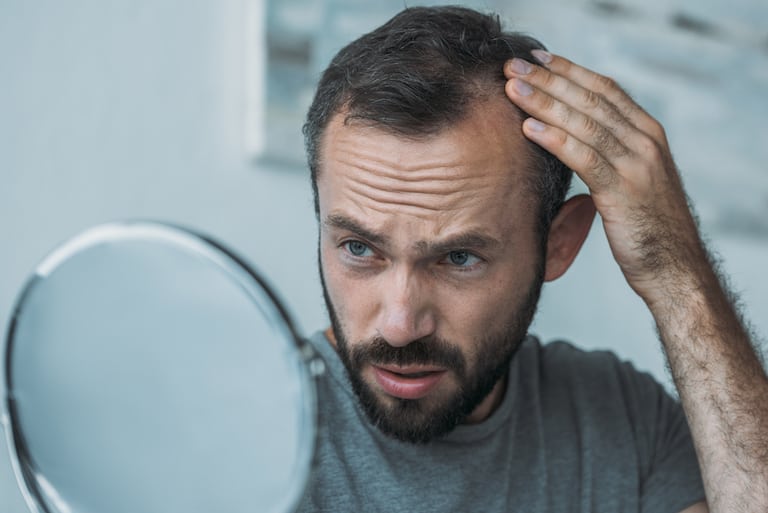Hair loss causes many me extreme anxiety. A receding hairline or a bald patch’s arrival can dramatically affect a man’s confidence and body image.
What is male hair loss?
Male pattern baldness affects up to 30 percent of 30-year-old men and 50 percent of 50-year-old men. It occurs distinctly (and sometimes can affect women, too, especially after menopause when oestrogen’s protective effect is lost). Hair may start to disappear from the temples and the crown of the head at any time. For a few men, this process begins as early as the later teenage years, but for most, it happens in their late 20s and early 30s. A little thinning of the hair may be noticeable first, followed by broader hair loss allowing more of the scalp to become visible.
Some men aren’t troubled by this process at all. Others, however, suffer great emotional distress associated with a lack of self-confidence and sometimes depression.
Causes and risk factors
Male baldness happens because of hair follicles’ oversensitivity to a hormone called dihydrotestosterone (DHT), which the body makes from testosterone (present in normal levels in the blood). This causes the hair follicles to make thinner and thinner hair until they eventually pack up completely. The receding hairline will gradually meet the bald patch to leave a thinning hair ring, which is finally lost for some men, leaving a completely bald scalp.
Other causes of hair loss, which may not follow this pattern, include:
- Iron-deficiency anaemia
- Under active thyroid
- Fungal scalp infection
- Some prescribed medicines
- Stress and trichotillomania where the anxious person pulls so much on their hair that it breaks or comes out
Can I stop it?
If there’s a reversible cause, it’s usually possible to stop hair loss. For instance, if it’s caused by iron deficiency, you can stop hair loss by replenishing the body’s iron stores.
Many treatments are available to slow down and even reverse the process of male pattern hair loss – some are successful, others aren’t. But many men find their hair loss slows down or stops for no apparent reason at a certain age anyway.
Should I see a doctor?
It’s a good idea to ensure an illness isn’t responsible, mainly if the hair loss is patchy rather than being in the typical male pattern distribution. Moreover, if the hair loss is accompanied by other symptoms (such as tiredness), blood tests may be necessary.
Your doctor will examine you to look for any skin disease evidence affecting the scalp or fungal infection. He may request a blood count and ferritin level to look for low iron and anaemia, and thyroid function tests. Skin scrapings may be done if there is a skin disease to look for fungal infection.
Women with male pattern baldness should be tested for raised testosterone levels and polycystic ovarian syndrome, which can also show high testosterone.
Treatments
- Wigs, weaves, and hair transplants are, obviously, the most direct form of treatment, while some advocate shaving or close cutting, making the hair loss less noticeable. Different hairstyles can create a fuller head of hair, or a close shave cut can make baldness less apparent.
- Herbal preparations that contain zinc, magnesium, iron, vitamin E, and other substances in various combinations can help.
- Finasteride is an oral drug treatment. It works by preventing the conversion of testosterone to dihydrotestosterone, and so the hair doesn’t thin. It can take several months to start to show an effect and may take up to two years for hair to re-grow, but it works for most men, although not all, and cannot be used by women with male pattern baldness. It’s only available on prescription from your GP and is only useful during a course of medicine.
- Surgical techniques. Scalp surgery was used initially, moving flaps of skin with hair to areas without, but is less used now because hair transplant techniques have become refined, transplanting hair follicles from places such as the back of the head by the removal of a thin strip of scalp. Then the follicular units in it are replanted into the bald area. It is also suitable for women with male pattern baldness.
Sources:












